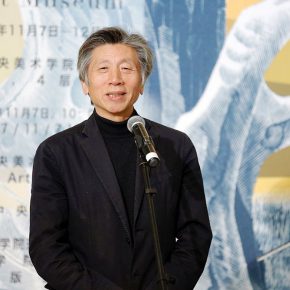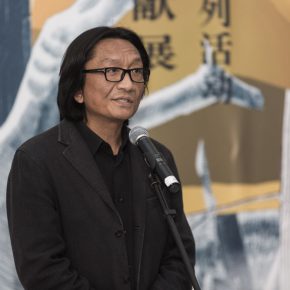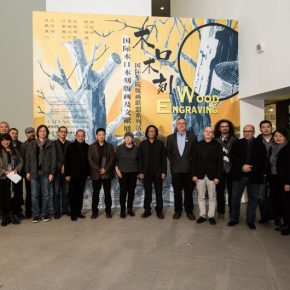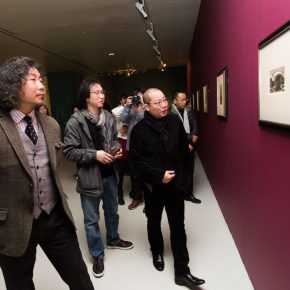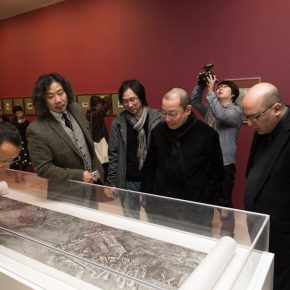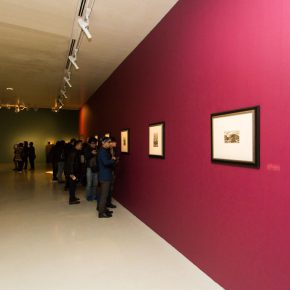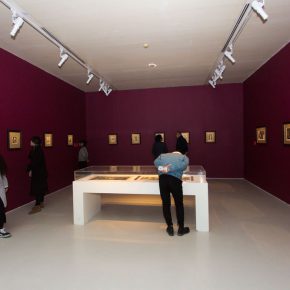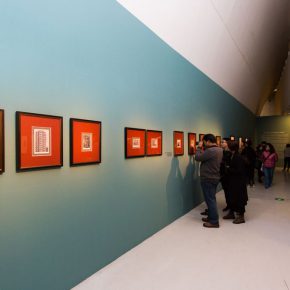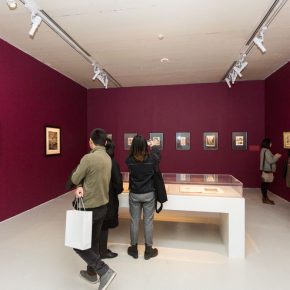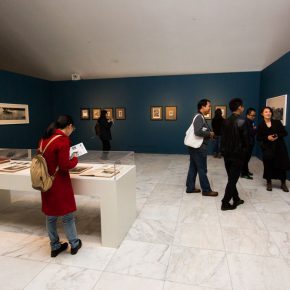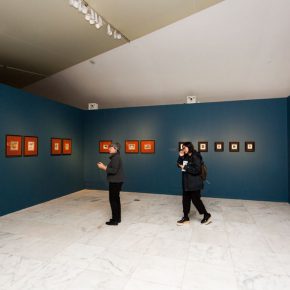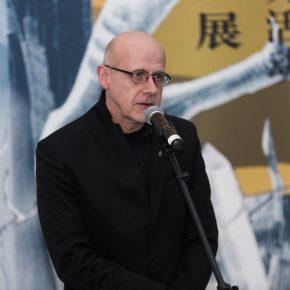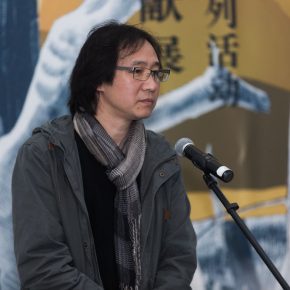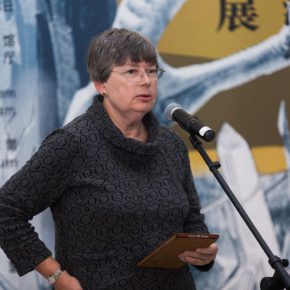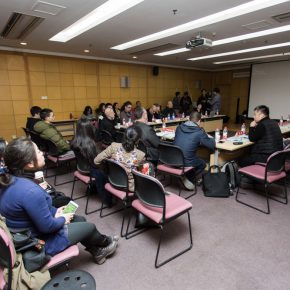
The contemporary development of printmaking art is an important topic in the whole development of contemporary art.
The International Academic Printmaking Alliance was initiated and established by the Central Academy of Fine Arts in 2016, and an international printmaking exhibition was held in the Imperial Ancestral Temple Art Museum in September of the same year. Fan Di’an, President of the Central Academy of Fine Arts, said that the establishment of the International Academic Printmaking Alliance meant that it offered a new platform to different international academies in the teaching of printmaking and the research of printmaking. It is a new opportunity for promoting the contemporary development of printmaking and the international exchange of printmaking teaching.
On the morning of November 7, 2017, the latest event of the International Academic Printmaking Alliance in 2017 – “International Grand Exhibition for Wood Engraving and Historical Archive” opened at the CAFA Art Museum. The exhibition is sponsored by the Central Academy of Fine Arts, jointly organized by the Department of Printmaking of the School of Plastic Arts at the Central Academy of Fine Arts, and the International Academic Printmaking Alliance. Wang Huaxiang, Chairman of the International Academic Printmaking Alliance and Director of the Department of Printmaking at the Central Academy of Fine Arts, acts as the Chief Curator, while Peter Bosteels, Dean of Printmaking Department at the Royal Academy of Fine Arts, Antwerp, Belgium/ A PUniversity College, and Geri Waddington, Chairman of The Society of Wood Engravers in the UK, act as the sub-curators, and Yang Hongwei, Secretary-General of the International Academic Printmaking Alliance and Deputy Director of the Department of Printmaking at the Central Academy of Fine Arts, is the Executive Curator of the exhibition.
“International Grand Exhibition for Wood Engraving and Historical Archive” is the first large-scale exhibition in China to showcase the contemporary state of wood engraving in the world. The exhibition presents more than 200 works by over 100 artists from nine countries, including the United Kingdom, the United States, Belgium, France, Russia, Bulgaria, Italy and China, covering the classical, modern and contemporary areas.
At the opening ceremony, Fan Di’an, President of the Central Academy of Fine Arts, said that, “Wood Engraving” was a wood engraving form that people were addicted to, on the one hand, it embodied the natural attributes of wood and on the other hand it showed the artist’s concentrated creative emotions. “International Grand Exhibition for Wood Engraving and Historical Archive” brings together the artists and works from different international colleges and universities, to study how to make the traditional printmaking form of wood engraving which now has a better development and is meaningful. President Fan Di’an pointed out: “Linking the tradition with the future is our academic responsibility today.”
Originated in the United Kingdom, Wood Engraving usually chooses to use a special knife made of a solid steel bar to carve, engraving on the fine, adamant end grained surface, because the wood fibers are uniformly erected, without distinction between the vertical and horizontal textures, which are not easy to crack, suitable for engraving, thus finer lines and more delicate changes on the layers could be achieved, then wood engraving carries the expression of woodblock print to the extreme. Wood engraving breaks with the main expressive means of black lines in traditional woodcuts and uses a range of degrees of gray, from black to white to compose its image, which makes the picture more delicate.
China is the birthplace of printmaking – the oldest woodblock print that exists in the world can be traced back to the Buddhist painting of the Vajracchedika-Sutra, found in the Dunhuang Grottoes, which was carved in the 9th year of Xian Tong of the Tang Dynasty (AD 868), which was five hundred years earlier than the woodblock print found in Europe. During a long period, although the tradition of woodblock print developed both in the Orient and Europe, different approaches were developed due to different humanities and different cultural connotations. Geri Waddington, Chairman of The Society of Wood Engravers in the UK, pointed out this remarkable difference: the most obvious thing was the chromatography of the oriental print which was in stark contrast to the black-and-white line engraving of the medieval European woodblock print, while the artists who drew images with lines and the artists who engraved wood formed a different division of labor. Wood engraving was not imported into China until the mid-20th century, and China was not familiar with this technique of printmaking before it was introduced to China.
The British printmaker Thomas Bewick (1753-1828) expanded and improved the techniques and materials of traditional woodblock printing, through wood engraving to revive woodblock printing and he was known as the “Father of Wood Engraving”. He used the end grain surface rather than wood plate to engrave, which did not only engrave more exquisite lines, but also made the wood surprisingly durable – depending on statistics, some wood engravings by Bewick were already printed 900,000 times when Bewick was still alive, nowadays we are still able to use many wood plates for printing clear images and these also feature some of the works in the “International Grand Exhibition for Wood Engraving and Historical Archive”.
Along with the dramatic improvement and development of the technology of photography & printing, the development of printmaking is facing difficulties. Especially the wood engraving which was characterized by “the earlier pioneers that led to mechanical reproduction” has gradually lost the advantage in visual image communication. Peter Bosteels, Dean of Printmaking Department at the Royal Academy of Fine Arts, Antwerp, Belgium/ A PUniversity College and a wood engraver, said that wood engraving was a technique “hovering in the dark”. The disappearance of commercial functions, a large number of professional engravers changing their profession and the loss of students led to the reduction of teaching, the complex skills making beginners retreat and the public aesthetic of printmaking has gradually subsided, making the future of wood engraving more difficult.
Under this background, the Central Academy of Fine Arts held the “International Grand Exhibition for Wood Engraving and Historical Archive” with a special mission and the contemporary value. The International Academic Printmaking Alliance was initiated and established to promote the printmaking academic development, researching & exploring the irreplaceability of printmaking in the context of global contemporary culture & contemporary art. In addition to the holding of “International Grand Exhibition for Wood Engraving and Historical Archive”, it will also hold symposiums from November 17 to November 18, to focus on the contemporary development & current status of the traditional skills of wood engraving. Meanwhile, the organizer invites the engravers from the United Kingdom, Belgium and Italy to participate in a typical workshop of wood engraving for engravers.
Although printmaking is no longer a mainstream art in the contemporary art field, with the efforts of many printmakers, we find some surprising changes taking place in the industry – people gradually rediscover the value and quality of printmaking, and the students are interested in the latent energy of printmaking again, in the emerging art language, ancient crafts have been paid more attention in the new visual communication, which is the purpose for the establishment of The International Academic Printmaking Alliance.
At the dawn of the global information age, how to make wood engraving become embodied in the value of the unique language and develop a new artistic expression in the face of a new development of global science & technology, and adapting the contemporary artistic environment, thereby to burst a new vitality under the support of new technology, new media and new methods, is the most important value for hosting this “International Grand Exhibition for Wood Engraving and Historical Archive”.
Text by Lin Jiabin, translated by Chen Peihua and edited by Sue/CAFA ART INFO
Photo by Yang Yanyuan/CAFA ART INFO
Photos of works courtesy of the organizer
Words for Wood Engraving Exhibition
By Wang Huaxiang, Chairman of IAPA, Dean of the Department of Engraving Prints
From the 17th century when it was first established as a technique to the mid of the 20th century, wood engraving remained anonymous in China. In fact, the practice of original woodcut is also quite new as it was introduced to China only some ten years earlier than wood engraving. Similar to Chinese engraving on wood, wood engraving appeared mainly as a reproductive and printing method, instead of an independent form of artistic expression. The difference is that Chinese craftsmen use lines while their Western counterparts use tones. To some extent, wood engraving was the product of the need to lively and exactly replicate the original canvas or sketch for printing purposes. The inventors of wood engraving discovered the potential of the use of the graver on end-grain boxwood for cutting unprecedented fine and delicate lines, which would create a variety of tones. This opens up the door to a whole new world for later engravers and artists and brought about new possibilities to illustrators.
With the development of photography and printing technologies, engraving prints as a printing process and related techniques gradually sunk into oblivion together as paintings used primarily for recording. However, as a unique form of artistic expression, painting, engraving prints, woodcut and wood engraving still existed and developed, although never having been the mainstream. Some practitioners have continued their exploration in the field with passion and love after the initial panic. Today, a few Chinese academies offer wood engraving courses, which is quite popular. Wood engraving works are also sought-after by collectors. In the past three to four decades, China enjoyed rapid economic development and at the same time, extensively learned from Western and global experience in culture, technology and political governance. It is the same with art. So I have been wondering what can I do to contribute to the development of engraving prints. Establishing the International Academic Printmaking Alliance (IAPA) to build an international platform for the practicing and teaching of engraving prints is an important step to realize the goal. It is the establishment of IAPA that made the International Wood Engraving Prints and Literature Exhibition a Reality. At last, I would like to thank artists from all over the world, members of IAPA, leaders of the Central Academy of Fine Arts, the Art Gallery of Central Academy of Fine Arts and everyone participating in the organization of the event. I would also like to especially thank my assistant and vice dean of the department of engraving prints Professor Yang Hongwei for the efforts he made to make the exhibition a success.
2nd November, 2017
Beijing 2017 International Grand Exhibition for Wood Engraving and Historical Archive
By Geri Waddington, Chairman of The Society of Wood Engravers in the UK
From its beginnings in the hand prints of prehistory relief printmaking has always retained an immediacy and directness concomitant with the simplicity of the method, and for thousands of years wood has been the surface of choice for relief prints. Indeed one of the earliest recorded woodcuts was made here in China; an image of the Buddha cut in 868CE.
As woodcut tradition developed in the both the East and in Europe the method grew in different directions. Most obviously, the use of colour in oriental prints contrasted with the black line engraving common in medieval European woodcuts, where a division of work between the artists who drew the images and the artisans who cut them in wood became established.
The Renaissance wood engravings of Albrecht Dürer are a classic example of the latter; drawn by the artist on the long grain of a closely grained wood such as pear or box , the image was then cut by skilled “formschneider” who laboriously rendered the black lines laid down by cutting around them. This division of labour between artist and technician persisted for centuries, and along with it what seems to us now a rather unnatural approach of cutting around lines rather than engraving white marks. A simple demonstration of this would be to consider the rendering of cross hatching on a the wood block; to produce # in white lines would take four cuts, whereas the same figure in black line would require thirty two. No wonder cross hatching was particularly unpopular with the artisan engravers!
The technique of wood engraving as we know it today derived mostly from the methods developed by one man, Thomas Bewick. Born in Northumbria in 1753, at the age of fourteen he was apprenticed to a company of copperplate engravers, but he soon showed a particular aptitude for engraving on wood, and this became his life’s work. Most notably, he introduced the concept of white line engraving, a much more expressive use of the traditional tools which allowed the rendering of a wide range of tones and texture, an effect of ‘drawing with light‘which most wood engravers favour to this day.
Among Bewick’s other crucial innovations was the use of end grain surfaces to engrave on rather than working on the plank. By choosing a tight and evenly grained timber such as box and working on the cross-section with tools derived from metal engraving he was able to produce much finer marks than obtainable in woodcuts made on the long grain with gouges. A bonus to the switch from plank to endgrain was the astonishing longevity of the latter; Bewick calculated that some of his blocks had been printed from 900,000 times in his lifetime, and many are still producing crisp impressions today, as shown in this exhibition. He also developed the technique of ‘lowering’, carefully scraping a very small layer of wood from certain areas of the block before engraving them so that those passages received less pressure from the press and consequently printed lighter.
The pinnacle of Bewick’s work must be his Histories of Quadrupeds and Birds, for the beautiful rendering of the subjects and also the inventiveness and humour of the tail-piece vignettes, tiny gems of social comment. At almost the same time visionaries such as William Blake and Samuel Palmer were producing lyrical pastoral engravings steeped in atmosphere and poetry, which could hardly have been more different from the meticulous observation of Bewick’s works. But soon the mainstream of the art moved away from such individual visions to a more prosaic but equally skilled application.
The technical advances made by Bewick were capitalised on by succeeding generations of nineteenth century engravers, but the creative element of the craft took a step back as wood engraving reverted to a collaboration between artist and artisan. So-called trade-engravers rendered the drawings of artists as faithfully as possible by reverting to a large extent to black-line engraving. The skill these men developed was impressive, and companies such as the Dalziel Brothers became famous for the quality of their cutting. The vast majority of these engravings were made to illustrate books or periodicals, and the largest examples such as the folding panoramas produced for the Illustrated London News comprised a number of blocks worked by individual engravers then assembled together to form the image. A master-engraver would then have the job of making the transition from one engraved block to the next as near invisible as possible.
For most of the nineteenth century wood engraved book illustration burgeoned under this two-handed system, and it wasn’t until the end of the nineteenth century, when other commercial methods of reproduction threatened its monopoly that the time of the artist-engraver returned.
As the demand for wood engravings continued to fall off from the early 20th century, it was replaced by a hugely creative flowering of artist-engravers working through the whole process from sketch to the finished print either as works for the wall or for the high quality private presses which sprung up at the same time.
The Society of Wood Engravers was founded in 1920, by a group of artists including Eric Gill, Lucien Pissarro, Gwen Raverat and Robert Gibbings. They held annual exhibitions and were joined by Paul Gaugin, David Jones, Clare Leighton and John and Paul Nash among others. The great private presses of the nineteen thirties such as the Golden Cockerel Press and the Gregynog press commissioned wood engravings for their publications which resulted in some of the most beautiful books in British publishing history.
But the golden era didn’t last; the SWE thrived until the outbreak of war, when both materials and commissions became difficult to obtain. After a brief resurgence post-war, the annual exhibitions ceased and it was left to determined individual artists such as Monica Poole to keep the flame burning through the nineteen sixties and seventies.
It was in the 1980s that a new generation of engravers took up the reins and the Society was revived. It has grown over the decades and established an international reputation for excellence, attracting members from around the world. This coincided with a revival in the Private Press movement in Britain, with presses such as Whittington and Fleece commissioning wood engravings to accompany the letterpress they use, as blocks have always been made ‘type-high’ to sit with lead type on the press.
Many engravers of my generation have been self-taught, and certainly, when I was at art school I never encountered the technique. Its pre-eminence as a medium for book illustration had long been eroded by more productive modern alternatives in commercial printing, and to a certain extent this reflected on the availability of wood engraving tuition in art schools. It is of course vital that the technique is passed on to future generations, and as a Society we have several strategies to offer help and encouragement to young engravers. Nevertheless, there is still some way to go to reinstate wood engraving as a stand-alone art form in British art schools, rather than being a unit in design or illustration courses. The teaching of the discipline at CAFA and beyond is a truly inspiring phenomenon.
This brings us to the present state of the art form, and the implications for its future. Two elements present themselves for scrutiny, technical and artistic developments, although of course the two are inextricably linked. Quite a few of us now use non-wood alternatives such as Resingrave, Corian or vinyl. These are cheaper than wood and a little more forgiving in that mistakes can be fairly easily corrected, but opinion is divided on their use.
Different countries have different woods, the Americans use maple for example, but whatever the wood, the skill involved in block making is considerable. British wood engraving hit a supply crisis a few years ago when our supplier of blocks since the nineteenth century, T N Lawrence, decided that the demand from wood engravers did not justify the cost of the equipment to continue production. Happily we were able to set up one of our members, Chris Daunt, with the necessary kit, and he is providing a source of excellent quality blocks to order.
We are seeing printed images used more freely in recent years, particularly the use of collage, and some three dimensional works are appearing. Mixed media offers many exciting possibilities, and of course colour has been used in wood engraving since its beginning. Other innovations in the engraving process itself include the use of fine electric drills, and no doubt more innovations will follow, but I am confident that the central core of hand skill required to use our traditional tools will remain unnegotiable.
This exhibition shows without any doubt that wood engraving is alive and well and opening its doors to the world and to innovation. We have addressed the task of giving a historical context from different parts of the world while also showing the range of approaches and traditions that form part of wood engraving today. It is a rallying call to wood engravers across the globe to share our knowledge with each other and the next generation and to profit from our difference experiences, and an invitation to all interested in the art to feast their eyes on a unique collection assembled from three continents.


